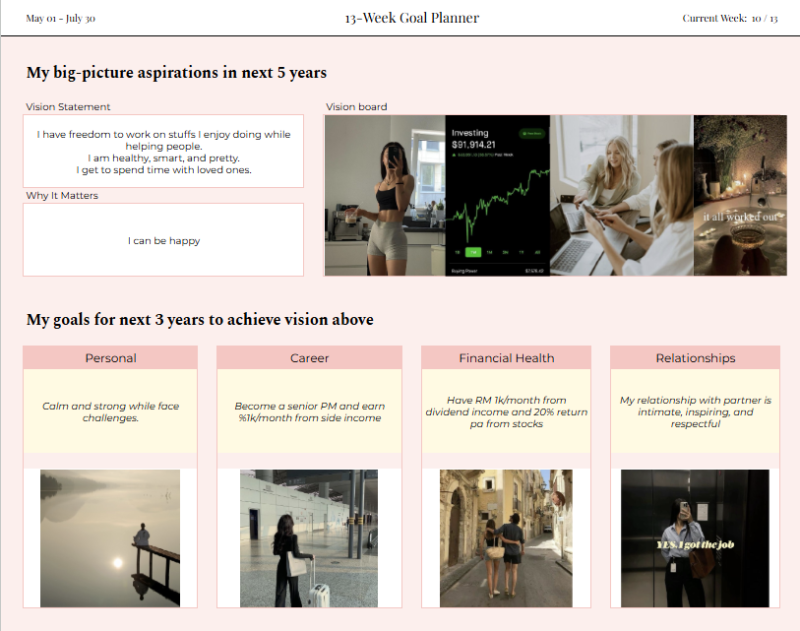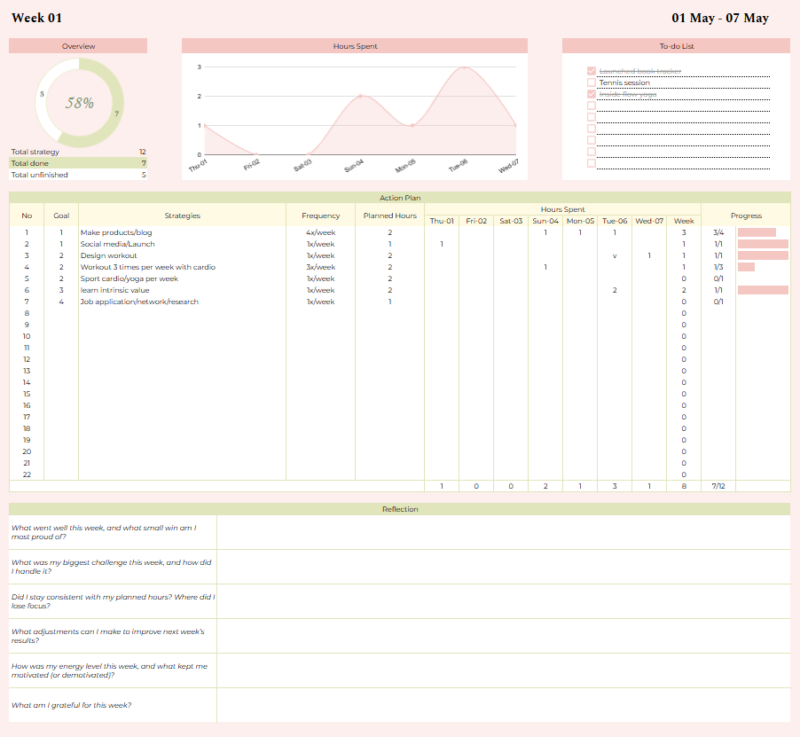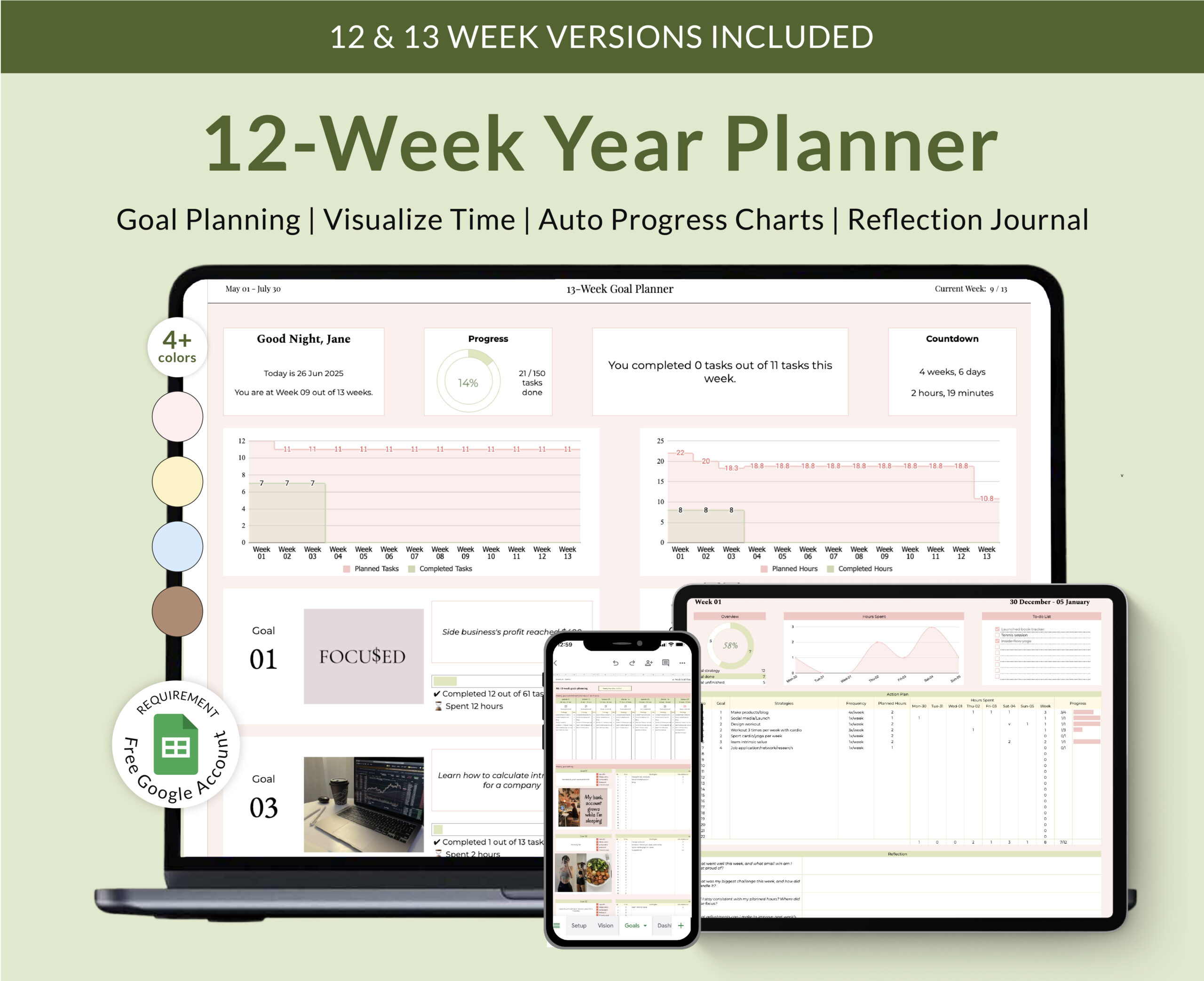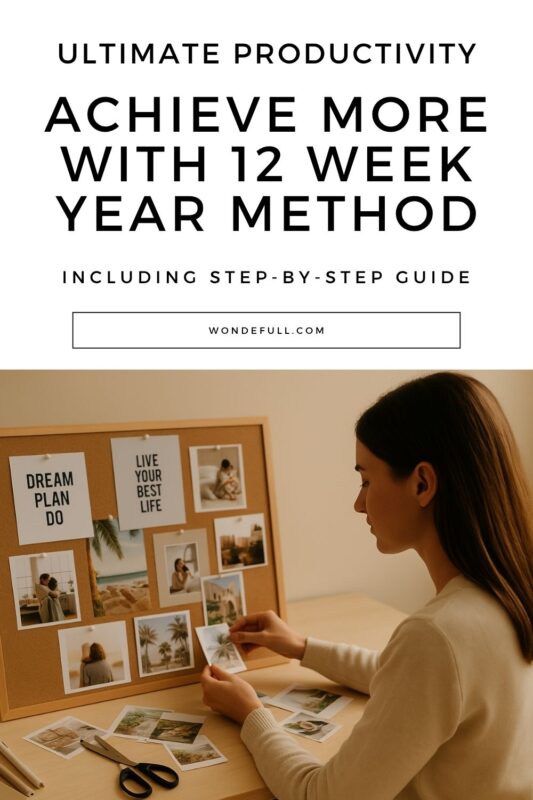Ever felt that traditional annual goal-setting falls short? Learn about the 12 Week Year Method—a framework that enhances productivity by reshaping how we plan our time and track our achievements.
Breaking Down the 12 Week Year Method
The 12 Week Year is a productivity system developed by Brian P. Moran and Michael Lennington, introduced in their 2013 book titled “The 12 Week Year: Get More Done in 12 Weeks than Others Do in 12 Months.” This is where I learned the goal methodology from.
The 12 Week Year reframes our perception of time, breaking the annual cycle into manageable, focused quarters. It challenges the traditional approach of annual goal setting by:
- Treating every 12 weeks as a “year”
- Focusing on shorter planning cycles for better urgency, focus, and execution
- Encouraging weekly and daily accountability instead of yearly resolutions
If you have worked in a fast-paced company before, this might sound familiar to you. I have always worked in SaaS tech companies, so quarterly OKRs planning and tracking are common. By breaking down big dreams into actionable short-term goals, the urgency and accountability will promote a resilient growth mindset that knows what to prioritize and make things work.
One foundational principle of the 12 Week Year method is the concept of intense focus each week. In traditional goal-setting schemes, the common practice is to set yearly objectives, often leading to slouching and procrastination. However, the 12 Week Year approach propels everyone to treat each week as a vital component of the larger goal. The urgency and importance of each week can motivate people to push forward.
Another key aspect is the emphasis on execution over mere planning. The 12 Week Year encourages not just setting objectives but also plotting a clear course of action and identifying key weekly strategies. It’s a shift away from the simplistic view of goal-setting to one that values results driven by consistent action.
Moreover, the continuous weekly cycle of evaluation and adjustment allows users to recalibrate. If you fall short one week, you don’t start over – you simply pivot and move forward. Each week becomes a fresh opportunity to realign with your goals. This mindset would reduce unproductive guilt and greatly enhance the overall effectiveness and follow-through.
I remember the first time I applied the 12 Week Year in my own life. I had always struggled with meeting my New Year’s resolutions, often finding myself lost in a sea of good intentions that faded by midyear. Then, I started quarterly planning in April 2023, but the execution fell short. I found myself underachieving as I underestimated the effort and time needed for each goal.
Embracing the 12 Week Year changed everything since I started using it in January 2025. You can read all my entries here, where I shared my quarterly review and planning. At first, I was a bit overwhelmed with the tracking. As weeks rolled by, I got used to the check-ins and reflections. Those help me assess my energy levels and physical capabilities, so that I can adjust my strategies accordingly to avoid burnout and illness. After two quarters of following the 12 Week Year, I’m totally in love with it as it enables me to continue improving in all aspects of my life, sustainably and productively.
Essential Steps for Setting Up Your First 12 Week Year
To successfully embark on your first 12-Week Year journey, it’s essential to approach the setup process with intentionality and clarity. I will demonstrate using my 12 Week Year Google Sheets template. Feel free to create your version following the steps below.
1. Defining Your Vision
- Reflect on Your Life Goals: The 12 Week Year method isn’t just for professional goals—it can be adapted to all areas of life, from career and education to personal health and family. For example, professionals can break projects into focused 12-week phases, students can target academic milestones, individuals can build sustainable fitness and wellness habits, and families can prioritize quality time through weekly bonding activities. I target a few areas in each 12 Week Year. So, set aside time to contemplate what truly matters to you and jot down your thoughts.
- Craft a Vision Statement: Summarize your reflections into a compelling vision statement. This should encapsulate your aspirations and serve as your North Star during the 12 weeks. Make it vivid and emotionally resonant.
- Visualize Success: Create a vision board or a digital representation of your goals. This can include images, quotes, or affirmations that inspire you. Keep it somewhere visible to reinforce your commitment daily.

2. Breaking Down Your Goals
- Identify Key Goals: Choose 2-4 major goals that align with your vision. For instance, if health is a focus, this could be losing weight, running a marathon, or incorporating daily exercise.
- Make Goals SMART: Ensure each goal is Specific, Measurable, Achievable, Relevant, and Time-bound. For example, instead of saying, “I want to exercise more,” specify, “I will work out for 30 minutes, five times a week.
- Know your free time: To avoid overestimating your energy and time, jot down your free time and plan your commitment accordingly.
- Break Goals into Actionable Steps: Divide each goal into smaller, manageable tasks. For example, if your goal is to write a book, actionable steps might include outlining the chapters, setting daily word counts, or scheduling weekly writing sessions.


3. Establishing a Weekly Routine
- Set a Weekly Review Day: Choose a day each week to jot down your progress and review. Assess what worked, identify challenges, and adjust strategies as needed. This reflection time is crucial for staying aligned with your goals.
- Plan Your Week: Each week, schedule time blocks dedicated to working on your tasks. Incorporate flexibility for unforeseen circumstances while ensuring you prioritize your essential activities.
- Accountability Check-Ins With Other Individuals: Seek an accountability partner or group that aligns with the 12 Week Year methodology. Regularly discuss progress, share struggles, and cheer each other on. This support can foster motivation and a sense of community.

Tools and Resources to Enhance Your 12 Week Year
To implement the 12 Week Year effectively, leveraging the right tools and resources can make a significant difference. Here are some personalized recommendations to help enhance your productivity during this transformative journey.

- 12 Week Year Planners: If you want to get started right away, a 12-Week Year Digital Planner is the easiest way to jump on because the planner is designed following the methodology. I created one based on my own experience and refined it across multiple goal cycles.
Other than the 12-week version, I also prepared a 13-week version for those who prefer planning over a full three-month period. The guide above was built using this template, and it comes in four aesthetic colour palettes to suit your style. You can purchase by clicking the button above. If you like to explore more options, look for them on Etsy! - Digital Apps: For tracking goals and managing tasks, consider using productivity apps that align with your approach.
- Trello and Asana: Excellent for visual learners, these enables you to map out tasks in a board format. If you want your documentation and tracking to be at the same place, Notion is your go to.
- Todoist and Any.do: If you like simple to-do list, check out these straightforward task manager where you can set deadlines and priorities effortlessly. For those who thrive on motivation and habit tracking,
- Habitica and Finch: Gamifies your habit tracking progress, turning goal achievement into a game where you earn rewards.
- Community Forums: Engaging with a community can provide accountability and encouragement. Platforms such as Facebook Groups dedicated to the 12 Week Year can serve as a space for sharing progress, insights, and challenges. Websites like Reddit and X also feature threads on productivity strategies, allowing you to connect with others on similar paths.
- Webinars and Workshops: To deepen your understanding and commitment, consider joining webinars or workshops led by experts in the 12 Week Year methodology. Here’s one hosted by the authors, offering firsthand insights from the creators themselves. These sessions provide valuable guidance, real-world examples, and a sense of community. If you prefer something free and flexible, check out Youtube videos where seasoned practitioners share about their experiences and how-to guides.
Common Pitfalls and How to Avoid Them
As individuals embark on the transformative journey of applying the 12 Week Year method, they often encounter common pitfalls that can derail their progress. Understanding these challenges and implementing strategies to overcome them is crucial.
One pervasive issue is procrastination. It’s easy to delay working on your goals when the idea of doing so seems daunting. To combat this, breaking goals into smaller, actionable tasks can significantly reduce the intimidation factor. Consider employing the “1, 2, 3… Go!” countdown technique. I used it often to prime myself to start something. When I felt demotivated to go to the gym, I would tell myself “1,2,3… change into a workout outfit and step out the door!” Honestlty, once I got myself out of the house, I always ended up at the gym doing my workout. The key to this mental cue is to help us bypass overthinking and just do it.
Another significant challenge is motivation. The excitement of starting a new goal-setting framework can quickly fade, leading to stagnation. To maintain motivation, it’s essential to celebrate small wins regularly! On my 12 Week Year template, I have a to-do list to cross off tasks I complete every week, and I note down the wins and what I’m grateful for in the weekly reflection section. This routine helps me recall the happy and proud moments, keeping the energy alive. Additionally, sharing your goals with someone who encourages you to stay on track can help maintain accountability and provide a robust support system.
It is also vital to acknowledge the emotional rollercoaster that comes with ambitious goal-setting. Feelings of doubt, frustration and inadequacy can creep in, especially when goals do not unfold in the way we want them to. Combatting this involves reframing failure as feedback rather than a setback. On my tracker, I document the reasons why I think things fail in the current week and how I can improve in the following week. Sometimes, I have to pivot and change the goals and strategies, which is completely fine. There are different paths to reach the destination, and we just need to find out which works best for us.
By being aware of these common pitfalls and implementing strategies to counter them, you easily boost your likelihood of success in the 12 Week Year method. Embracing these challenges as part of the journey not only fosters resilience but also cultivates a growth mindset that can continuously fuel your future aspirations.
Reflections and Scaling Success with 12 Week Year Method
Reflection is an integral component of the 12 Week Year process. To improve your chances of success, you need to reflect every week and also after the cycle ends. By analyzing what strategies led to success and what obstacles hindered progress, we unlock valuable insights that propel future planning.
Here are a few questions that you can reflect on at the end of your 12 Week Year cycle:
- Were certain goals unrealistic? Did you underestimate time commitments?
Understanding these nuances equips one to set more achievable objectives in subsequent cycles. - Did you change tactics/ tasks along the way? What’s the reason behind it?
Reflecting on why you pivoted will improve your ideation and planning. Was it due to a circumstance change, priority or mindset shift? - What are the successes? What tools, habits, or people helped you succeed?
Celebrate your successes, big or small. Reflecting on this fosters gratitude and reinforces what works. - What are the setbacks? What can be improved?
Understanding your obstacles helps you learn to take ownership of your decisions, learn from missteps, and build emotional resilience.
Reflection doesn’t merely serve as a retrospective activity; it becomes a proactive mechanism for improvement.
As you achieve more goals each cycle and gain more confidence, it is very important to use reflection to scale results. This is to avoid complacency, instead inspiring ambitious planning and execution.
By leaning into the power of reflection, you can innovate your approaches, expand your goals and drive meaningful transformation in your life. Each quarterly cycle becomes a stepping stone toward mastering your evolving capabilities and building your dream life.
Conclusion
The 12 Week Year method transforms traditional goal planning into a power-packed quarterly sprint. It’s helped me achieve goals I once struggled with, and I hope it empowers anyone seeking greater productivity, focus, and meaningful progress in both work and life.
Share on Pinterest if you enjoy this article!




